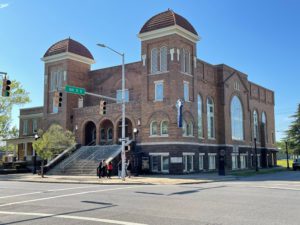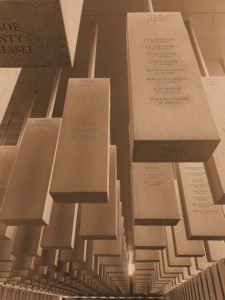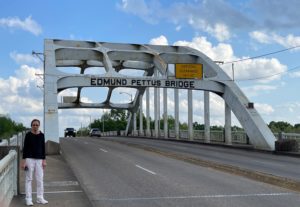By Alexis Williams
My husband Rickey and I recently traveled to Alabama to visit family, staying in Montgomery in the heart of civil rights history. We embarked on a journey through some poignant chapters of this era. As African Americans, we felt compelled to pay homage to the tragedies and triumphs of this time.
The Civil Rights Museum
 We started in Birmingham at the Civil Rights Museum—an incredible storehouse of information. We toured the 16th Street Baptist Church, the gathering place for civil rights meetings and protests. This church was bombed by four Ku Klux Klansmen on Sept. 15, 1963, claiming the lives of four African American girls. The only stained-glass window remaining on the side of the bomb blast contained the image of a white Jesus. This window remained intact except for damage to Jesus’ face and chest, interpreted as a sign that Jesus closed His eyes to the horror, and His heart was broken. Upon learning of this tragedy, a Welsh stained-glass maker designed a new window of a black crucified Jesus with one arm pushing against oppression and the other reaching toward reconciliation. Rainbow colors overhead depict the theme of diversity and Christ’s identification with all. Christ’s words are etched in the glass: “You Do It To Me,” a message about world problems of intolerance, denial of human rights, hatred, violence, and segregation. The window is beautiful to behold and encompasses messages that still resonate today.
We started in Birmingham at the Civil Rights Museum—an incredible storehouse of information. We toured the 16th Street Baptist Church, the gathering place for civil rights meetings and protests. This church was bombed by four Ku Klux Klansmen on Sept. 15, 1963, claiming the lives of four African American girls. The only stained-glass window remaining on the side of the bomb blast contained the image of a white Jesus. This window remained intact except for damage to Jesus’ face and chest, interpreted as a sign that Jesus closed His eyes to the horror, and His heart was broken. Upon learning of this tragedy, a Welsh stained-glass maker designed a new window of a black crucified Jesus with one arm pushing against oppression and the other reaching toward reconciliation. Rainbow colors overhead depict the theme of diversity and Christ’s identification with all. Christ’s words are etched in the glass: “You Do It To Me,” a message about world problems of intolerance, denial of human rights, hatred, violence, and segregation. The window is beautiful to behold and encompasses messages that still resonate today.
In Montgomery, we toured the Dexter Avenue Baptist Church—where Dr. Martin Luther King, Jr., began his pastoral ministry in 1956—and the parsonage where he lived with Mrs. King and two of their children. An indentation on the front porch marks the site of a bomb blast which miraculously did not injure Mrs. King or baby Yolanda who moved away from the front window moments before the blast.
The National Memorial for Peace and Justice
 Our visit to the Legacy Museum and National Memorial for Peace & Justice in Montgomery was particularly painful and poignant. The museum chronicles the history and horrors of slavery, including holographic images of enslaved men, women, and children in cells telling their own stories. It then moves to the brutal backlash against the freedoms and political gains of African Americans during Reconstruction with the rise of the Ku Klux Klan and ensuing waves of terror. Since Reconstruction more than 4,000 men, women, and children have been lynched. Jars of soil collected from lynching areas display the names, dates, and locations of victims. There are displays of segregation, Jim Crow, and the start of the civil rights movement. The museum shows the interconnection between slavery, lynchings, mass incarceration, the disproportionate number of black prisoners, and the current waves of police brutality. A final room holds a huge photo display of African Americans instrumental in the fight for equality.
Our visit to the Legacy Museum and National Memorial for Peace & Justice in Montgomery was particularly painful and poignant. The museum chronicles the history and horrors of slavery, including holographic images of enslaved men, women, and children in cells telling their own stories. It then moves to the brutal backlash against the freedoms and political gains of African Americans during Reconstruction with the rise of the Ku Klux Klan and ensuing waves of terror. Since Reconstruction more than 4,000 men, women, and children have been lynched. Jars of soil collected from lynching areas display the names, dates, and locations of victims. There are displays of segregation, Jim Crow, and the start of the civil rights movement. The museum shows the interconnection between slavery, lynchings, mass incarceration, the disproportionate number of black prisoners, and the current waves of police brutality. A final room holds a huge photo display of African Americans instrumental in the fight for equality.
From the museum, a shuttle transported us to the Memorial Center. This outdoor tribute to lynching victims felt sacred, solemn, and painful to behold. Over 800 steel pillars hang in rows overhead with names, locations, and death dates of over 4,000 victims from 1877 to 1950. For me, the site embodied this verse from Lamentations 1:1-2: “How lonely sits the city that once was full of people…She weeps bitterly in the night, with tears on her cheek.” One sobering find was the names of two men murdered in my hometown of Frankfort, Ky. Our visit fell on Palm Sunday, leading to Jesus’ passion, and left me wrestling with images of these lynching victims juxtaposed with images of the torture and ultimate lynching of Jesus and the message of resurrection and redemption through Jesus’ death.
We traveled to Tuskegee and toured the Tuskegee Airmen site—two hangers filled with information about these African American airmen. We learned that the training of Black fighter pilots was an experiment marked for failure to prove Blacks were incapable of holding such positions. Instead, it was a resounding success. Despite continued obstacles, these airmen displayed the tenacity and courage to earn multiple commendations and played an instrumental role during WWII.
 The Edmund Pettus Bridge
The Edmund Pettus Bridge
The last leg of our journey was to Selma. We walked across the Edmund Pettus Bridge, mindful of the “Bloody Sunday” violence against protesters on March 7, 1965, followed two weeks later by the triumphant march across the bridge to Montgomery where Dr. King delivered his voting rights speech. Their march took four days. Along the route, we saw markers for four campsites where marchers broke their journey, and a memorial to Viola Liuzzo, the white mother who joined the marchers from New Jersey and was murdered afterward by the Klan.
This trip left me even more aware that my husband, our daughters, and I stand on the shoulders of so many who endured unspeakable horrors for the opportunities we enjoy today. It was encouraging to see a number of white tourists also absorbing this history. In the current climate of racial polarization, there are attempts to suppress voting rights and to squelch the study of African American history, while some express a nostalgic longing to return to lynchings. These realities make the importance of preserving, discussing, and remembering this history glaringly apparent. Only then can hope for change stay ignited and true reconciliation be achieved through Jesus’ message of love and equality.
“Never let anyone…dampen, dim or diminish your light… Hold only love, only peace in your heart, knowing that the battle of good to overcome evil is already won.” (John Lewis)
 Alexis is a member of the JUST Words editorial board and a licensed clinical social worker. She and her husband are Springfield Dominican Associates.
Alexis is a member of the JUST Words editorial board and a licensed clinical social worker. She and her husband are Springfield Dominican Associates.


